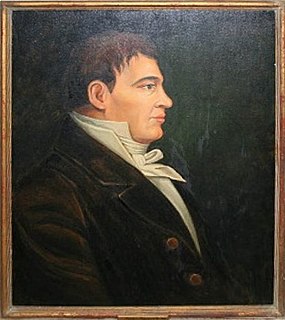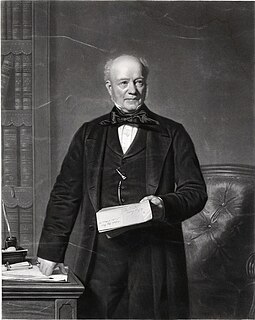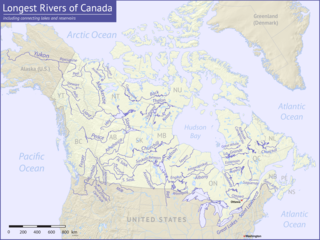This article needs additional citations for verification .(March 2014) (Learn how and when to remove this template message) |
John Finlay (1774 – December 19, 1833) was a fur trader and explorer with the North West Company. [1] He is best remembered for establishing the first fur trading post in what is now British Columbia, Canada and for his exploration of the Finlay River, one of the two major rivers forming the Peace River.
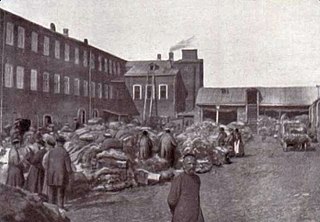
The fur trade is a worldwide industry dealing in the acquisition and sale of animal fur. Since the establishment of a world fur market in the early modern period, furs of boreal, polar and cold temperate mammalian animals have been the most valued. Historically the trade stimulated the exploration and colonization of Siberia, northern North America, and the South Shetland and South Sandwich Islands.

The North West Company was a fur trading business headquartered in Montreal from 1779 to 1821. It competed with increasing success against the Hudson's Bay Company in what is present-day Western Canada. With great wealth at stake, tensions between the companies increased to the point where several minor armed skirmishes broke out, and the two companies were forced by the British government to merge.

British Columbia is the westernmost province of Canada, located between the Pacific Ocean and the Rocky Mountains. With an estimated population of 5.016 million as of 2018, it is Canada's third-most populous province.
Finlay was born in Montreal, the son of James Finlay, who himself was a significant player in the western Canadian fur trade. Finlay was apprenticed as a clerk in the North West Company in 1789 at the age of 15. He accompanied Alexander Mackenzie on his historic trip across the Rocky Mountains to the Pacific Ocean in 1792-93 becoming, with him, the first European to traverse North America. He was placed in charge of the North West Company's Athabasca Department in 1794, and the same year established a trading post at present-day Fort St. John, called Rocky Mountain Fort. This was the first European community established in present-day British Columbia and is the province's oldest continuously inhabited European-founded settlement.
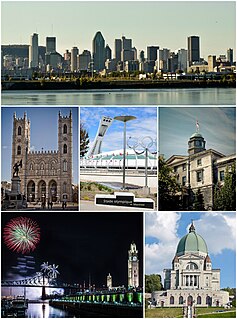
Montreal is the most populous municipality in the Canadian province of Quebec and the second-most populous municipality in Canada. Originally called Ville-Marie, or "City of Mary", it is named after Mount Royal, the triple-peaked hill in the heart of the city. The city is centred on the Island of Montreal, which took its name from the same source as the city, and a few much smaller peripheral islands, the largest of which is Île Bizard. It has a distinct four-season continental climate with warm to hot summers and cold, snowy winters.

Sir Alexander Mackenzie was a Scottish explorer known for accomplishing the first east to west crossing of North America north of Mexico, which preceded the more famous Lewis and Clark Expedition by 12 years. His overland crossing of what is now Canada reached the Pacific Ocean in 1793. The Mackenzie River, the longest river system in Canada and the second longest in North America, is named after him.

The Rocky Mountains, also known as the Rockies, are a major mountain range in western North America. The Rocky Mountains stretch more than 4,800 kilometers (3,000 mi) from the northernmost part of British Columbia, in western Canada, to New Mexico in the Southwestern United States. Located within the North American Cordillera, the Rockies are somewhat distinct from the Pacific Coast Ranges, Cascade Range, and the Sierra Nevada, which all lie farther to the west.
In 1797, Finlay revisited Mackenzie's excursion to the Pacific, with a view to taking the north branch of the Peace rather than the southern branch (the Parsnip River) taken by Mackenzie. This northern branch would come to be known as the Finlay River. Finlay perhaps thought that this route might present a less complicated conduit to the Pacific. No record remains of the expedition except in the writings of Samuel Black, who ascended to the source of the Finlay in 1824, noting that "he had studied Finlay’s chart." Nonetheless, it would appear from the information Black had that Finlay had only made it as far as the Ingenika River, about 130 km north of the Finlay River's confluence with the Peace. Indeed, Black's journal makes clear that the northern branch, far from being less complicated, was all but impassable in many parts, perhaps explaining Finlay's reluctance to travel more than about one-quarter of the river's actual length.
The Parsnip River is a 240-kilometre (150 mi) long river in central British Columbia, Canada. It flows generally north-westward from the Parsnip Glacier in the Hart Ranges to the Parsnip Reach of Williston Lake, formed by the impounding of the waters of the Peace River by the W.A.C. Bennett Dam in 1968. Prior to that, the Parsnip joined with the Finlay River to form the Peace at Finlay Forks, with both sharing an alignment along the Rocky Mountain Trench.
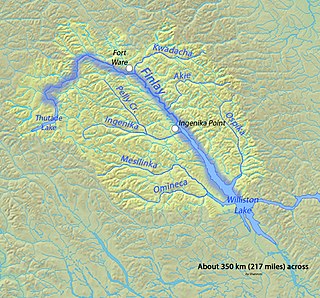
The Finlay River is a 402 km long river in north-central British Columbia flowing north and thence south from Thutade Lake in the Omineca Mountains to Williston Lake, the impounded waters of the Peace River formed by the completion of the W.A.C. Bennett Dam in 1968. Prior to this, the Finlay joined with the Parsnip River to form the Peace. The headwaters of the Finlay at Thutade Lake are considered the ultimate source of the Mackenzie River. Deserters Canyon is located just north of Williston Lake.
Samuel Black British fur trader and explorer, Clerk in the New North Nest Company (XYC) and Wintering Partner in the North West Company (NWC), and later Clerk, Chief Trader, and Chief factor in the Hudson's Bay Company (HBC) for the Columbia District. In 1824, he explored the Finlay River and its tributaries in present-day north-central British Columbia, including the Muskwa, Omineca and Stikine for the HBC, his journals later published by the Hudson's Bay Record Society in 1955.
Finlay remained in the North West Company's Athabasca Department, becoming a partner of the company in 1799. He retired from the fur trade in 1804 and returned to Montreal. Little is known of his life there, except that he obtained an appointment as deputy commissary-general.

